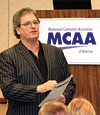
David
Allen, McKinstry of the Seattle, Wash. area, speaks to a packed room during the
MCAA Annual Convention in Maui. His presentation focused on building brand
equity among a contracting industry that is flooded with services.
“I’m not here to be compelling when you would rather be playing golf or on the beach. I’m here to be useful. So, if this going to be useful, you will want to follow along in the book and make some good notes.” The group of about 60 MCAA contractors in attendance at Allen’s educational breakout session about Driving Brand Value in Construction Firms, took heed.
During the interactive session, participants learned how to differentiate their company’s services from a cluttered market of construction service providers, and how to find that special something that drives their respective brands. Allen’s first instruction to the group was to write an obituary for their own brand. After a volunteer shared his obituary column, Allen rewarded the person with a copy of Neumier’s book, and continued to engage the audience with similar gifts throughout his presentation.
The purpose of writing the obit was to identify where the company has the most credibility; where it has the most experience, and where the passion of the brand lies. Being remembered fondly, as in death, was a means for the contractors to focus on a brand description for their companies.
Allen’s company is a mega-sized facility services provider from Seattle that expanded into energy services and now competes on a national scale. Regarding branding, Allen said, “Years ago we would get calls from customers who said, ‘I heard that your company is an expert in wastewater, or energy. When I hung up the phone I wondered what makes them think we can do that? Then, we had to catch up to what our customers thought we could do. That’s branding. They associated McKinstry with those certain attributes.”
Allen admitted the company had entered several markets before it was ready - “before we knew what we were doing.” He said that if someone is in the mechanical services industry, the right answer is always “Yes” when the caller asks if you can do something. Fulfilling the customers’ expectations of the “brand” your company presents is what it’s all about according to Allen.
TRENDS AND BRANDS
Trends in health care, sustainability, and even democracy, were discussed in light of how such trends could power one’s business going forward. Some companies ride one trend, some are able to ride more than one to success. Allen asked the group to make a list of trends that will power their business in the future, and then all discussed why a particular trend might be relevant in one market, yet not in another.For his own company, Allen said, “Data centers are going to be short by almost 1,000 locations by the year 2050. For us that’s a big trend.” For the industry in general he said, “Water. This industry can’t afford to miss this opportunity.”
Going through the 17-step process developed by Neumier, Allen reinforced several key concepts: Brand Perception, Brand Promise, Brand Experience, and Brand Loyalty. Allen said, “The point of this is to ask yourself, how good are you at delivering the same brand perception after delivery as the customer had of you at the beginning?”
Throughout the workshop, attendees took notes in their workbooks, and left with a brand-building template that enabled them to map their firms’ positioning strategy. Each left with a customized plan or brand map that could be used in their local markets.
Publication date:05/16/2011


Report Abusive Comment